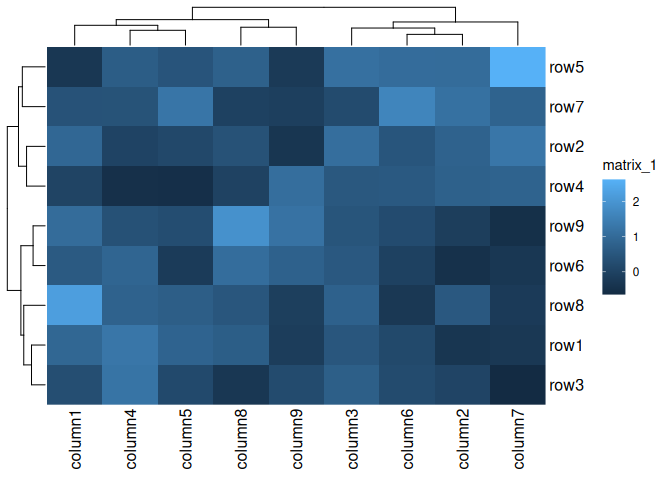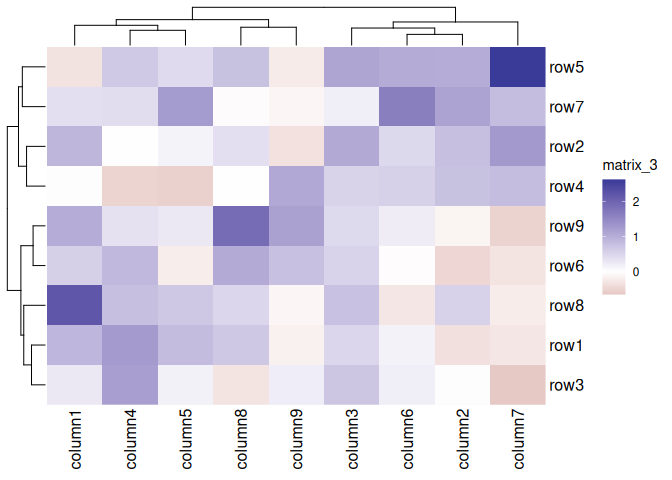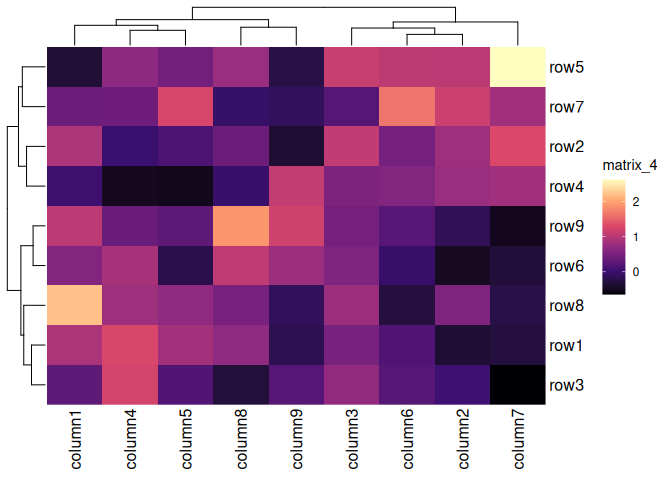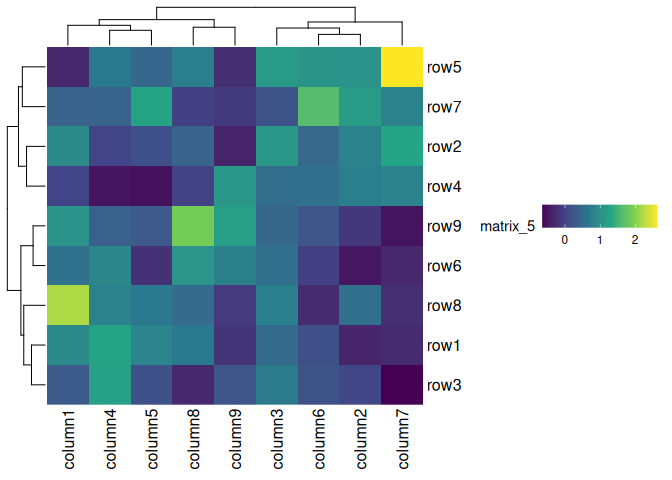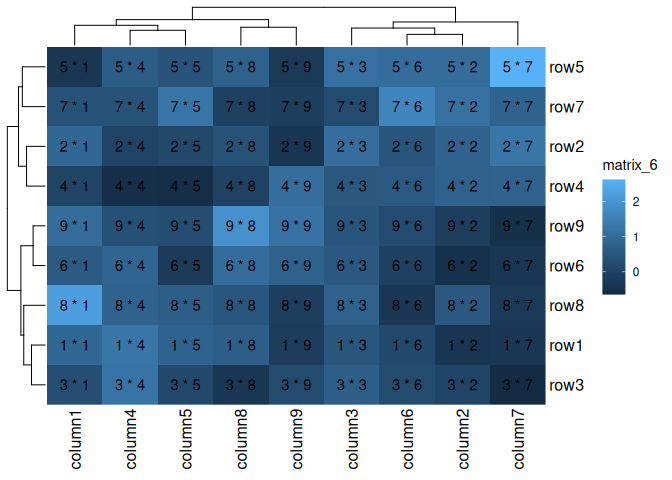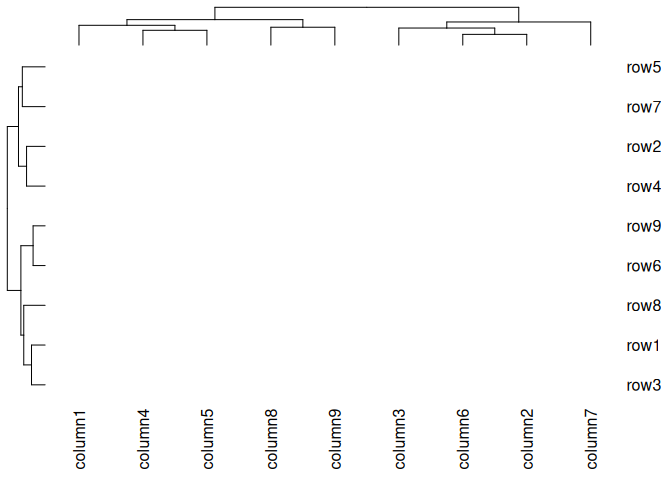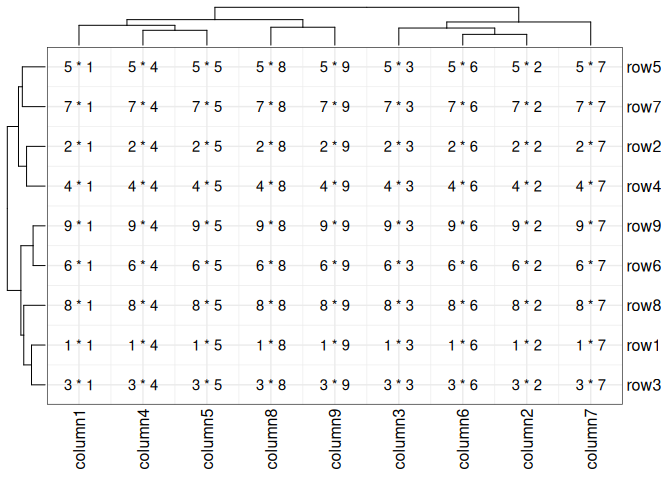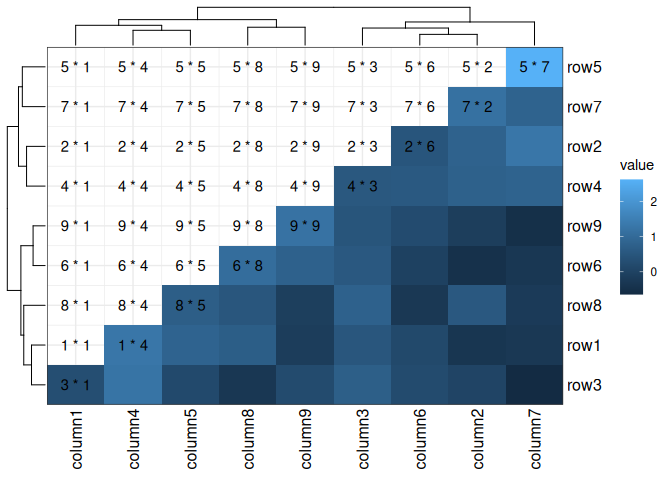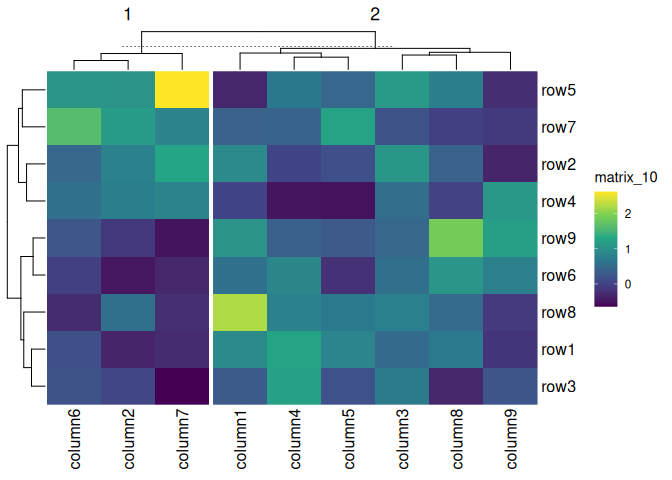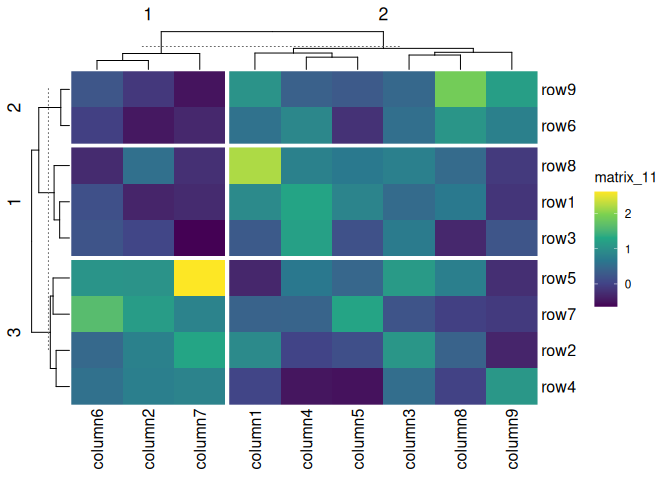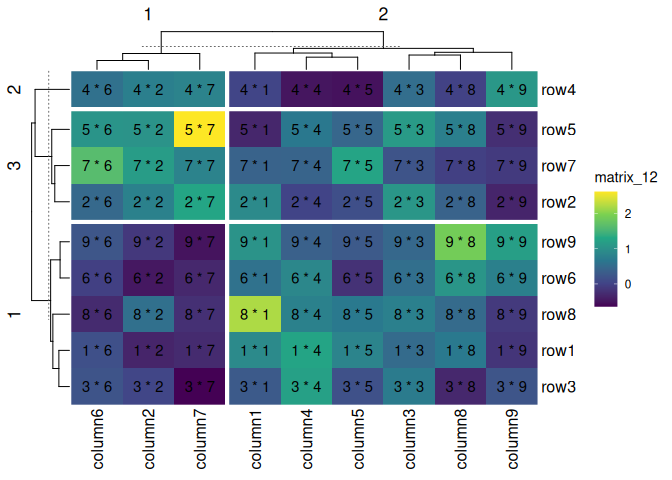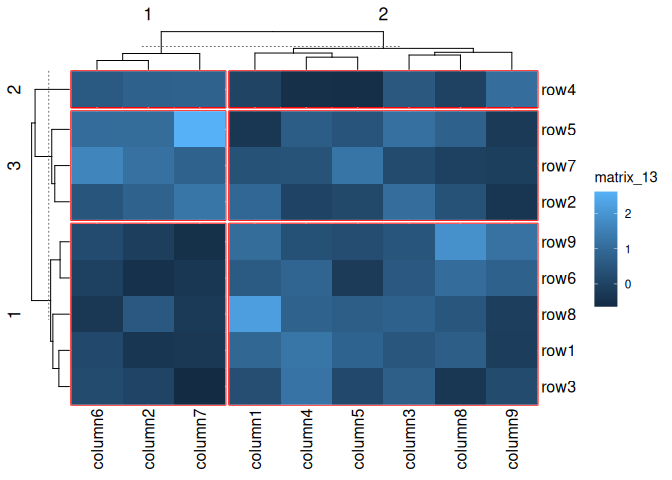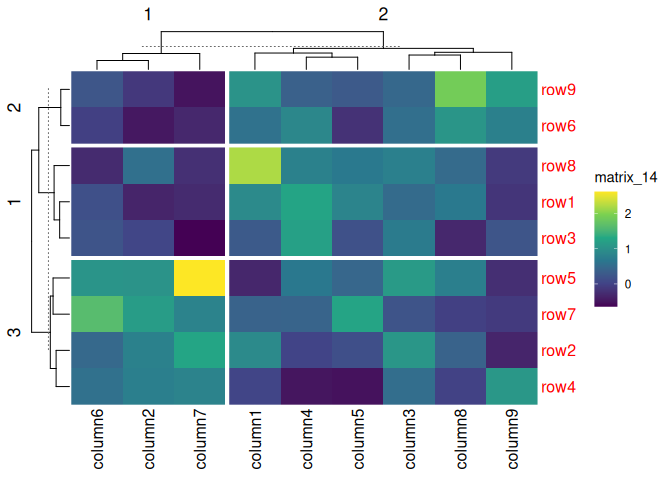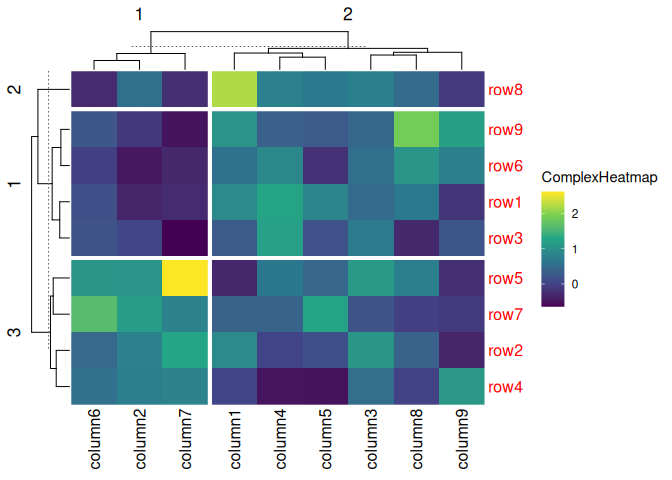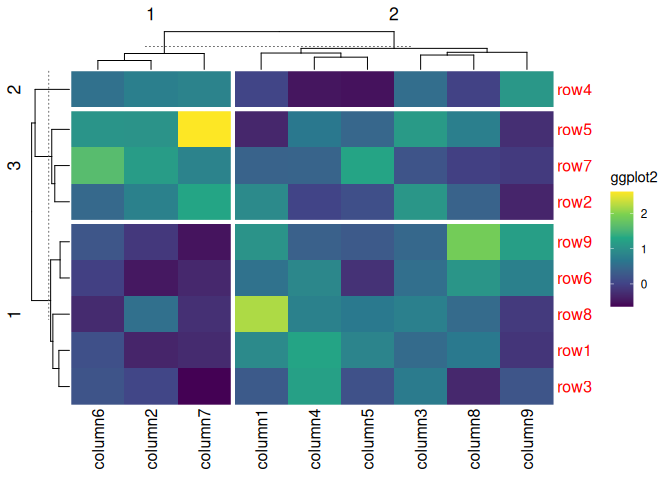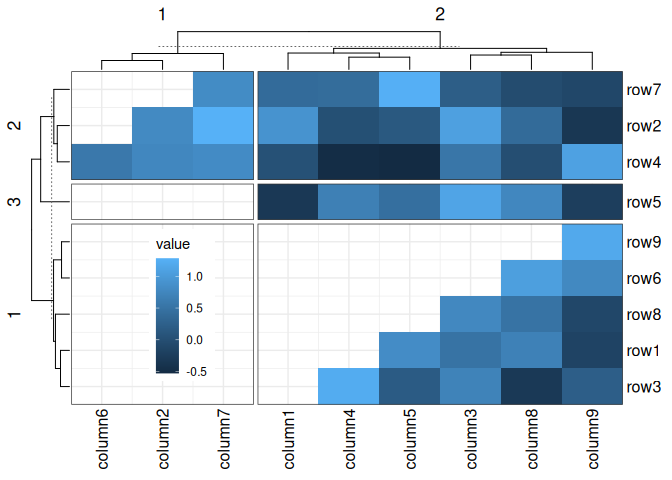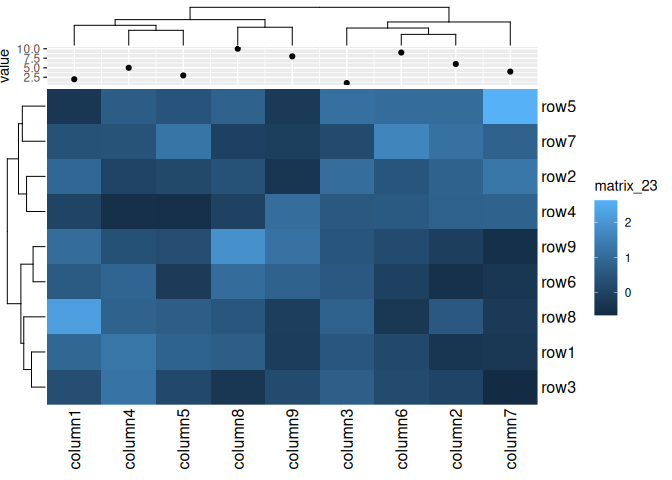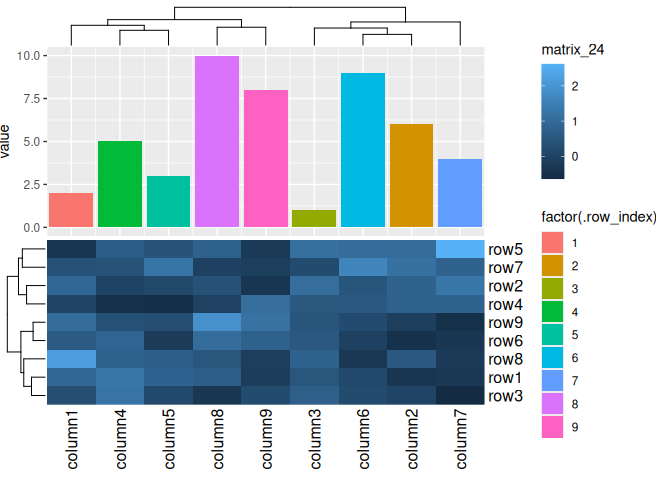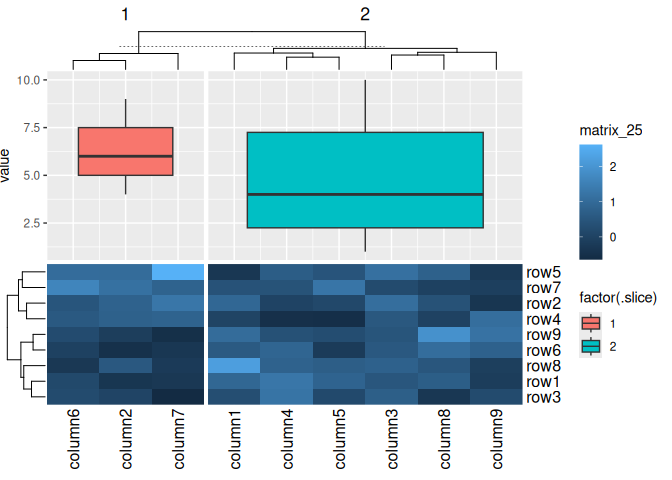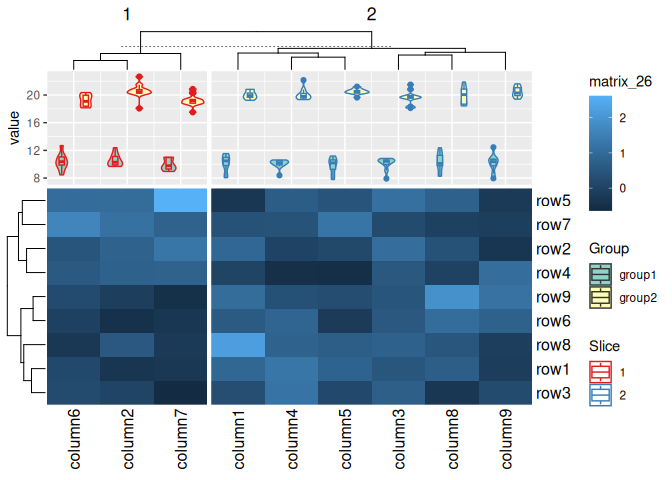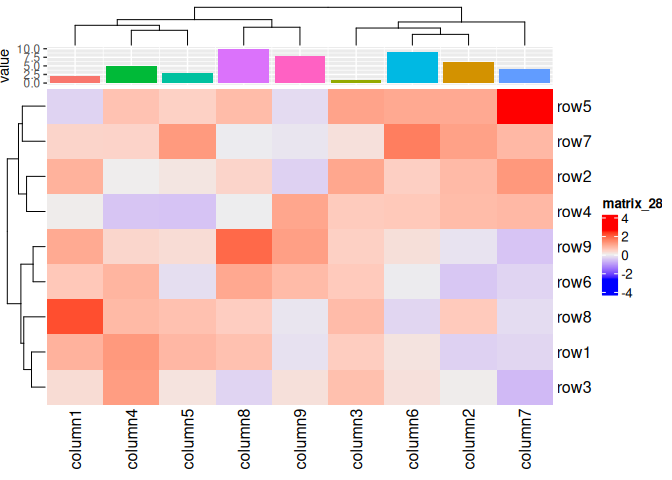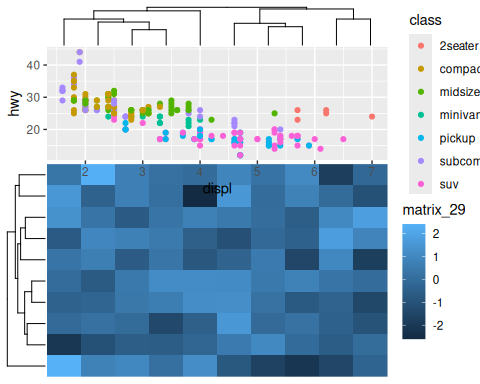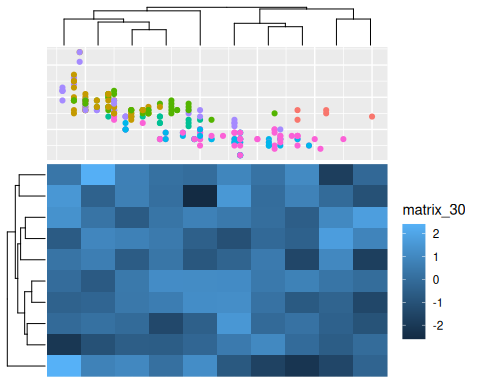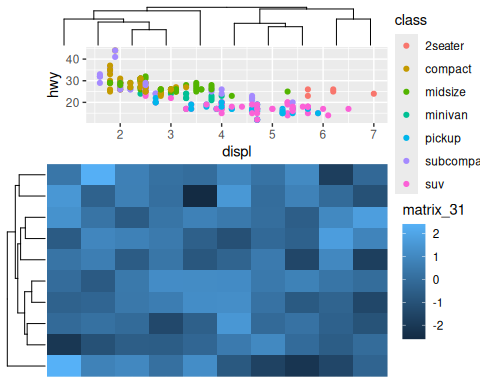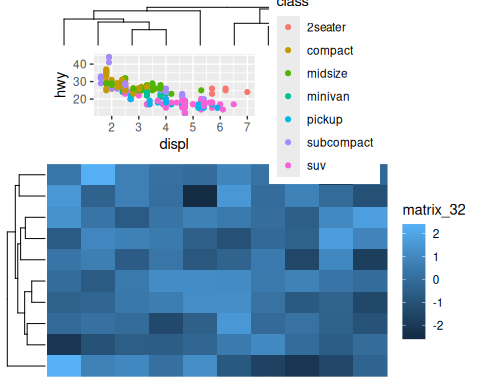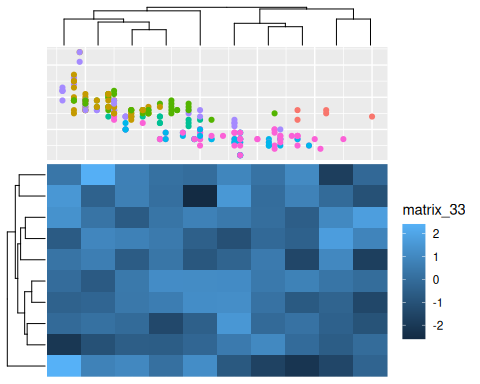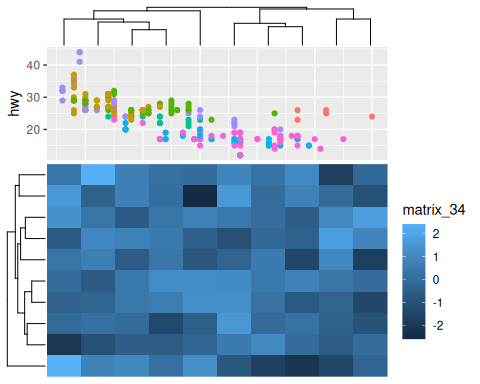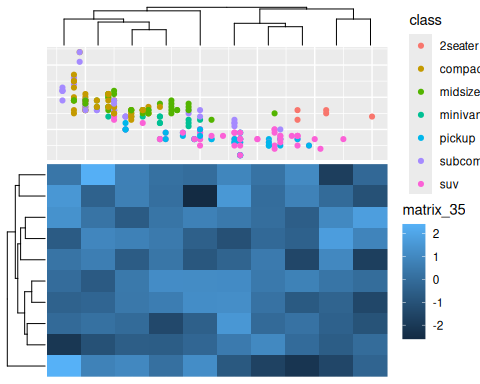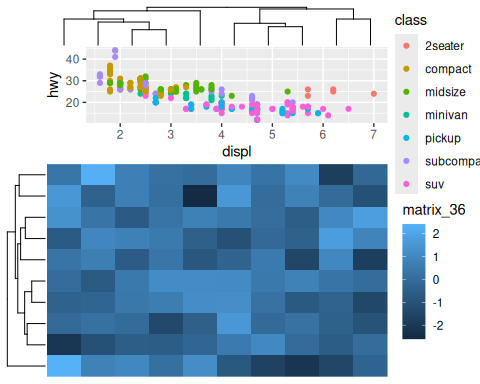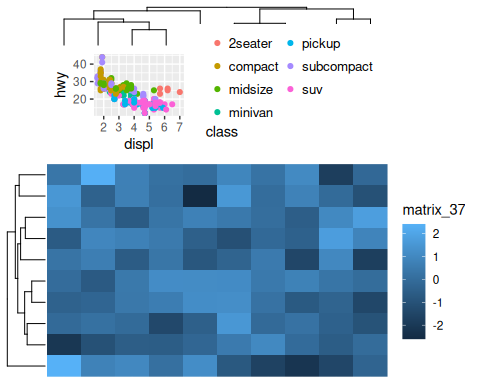Read this in other languages: English, 简体中文
This package serves as a bridge between the
ggplot2 and
ComplexHeatmap packages.
Essentially, all ggplot2 geometries and operations can be utilized in
ComplexHeatmap through the eheat package, with the exception of facet
operations (and you shouldn’t do it in eheat package). Fortunately,
ComplexHeatmap is capable of handling these operations independently,
rendering them unnecessary.
You can install the development version of eheat from
GitHub with:
if (!requireNamespace("pak")) {
install.packages("pak",
repos = sprintf(
"https://r-lib.github.io/p/pak/devel/%s/%s/%s",
.Platform$pkgType, R.Version()$os, R.Version()$arch
)
)
}
pak::pkg_install("Yunuuuu/eheat")library(eheat)
#> Loading required package: ggplot2Let’s begin by creating some example data, following code was copied from ComplexHeatmap book directly
set.seed(123)
nr1 <- 4
nr2 <- 8
nr3 <- 6
nr <- nr1 + nr2 + nr3
nc1 <- 6
nc2 <- 8
nc3 <- 10
nc <- nc1 + nc2 + nc3
mat <- cbind(
rbind(
matrix(rnorm(nr1 * nc1, mean = 1, sd = 0.5), nrow = nr1),
matrix(rnorm(nr2 * nc1, mean = 0, sd = 0.5), nrow = nr2),
matrix(rnorm(nr3 * nc1, mean = 0, sd = 0.5), nrow = nr3)
),
rbind(
matrix(rnorm(nr1 * nc2, mean = 0, sd = 0.5), nrow = nr1),
matrix(rnorm(nr2 * nc2, mean = 1, sd = 0.5), nrow = nr2),
matrix(rnorm(nr3 * nc2, mean = 0, sd = 0.5), nrow = nr3)
),
rbind(
matrix(rnorm(nr1 * nc3, mean = 0.5, sd = 0.5), nrow = nr1),
matrix(rnorm(nr2 * nc3, mean = 0.5, sd = 0.5), nrow = nr2),
matrix(rnorm(nr3 * nc3, mean = 1, sd = 0.5), nrow = nr3)
)
)
mat <- mat[sample(nr, nr), sample(nc, nc)] # random shuffle rows and columns
rownames(mat) <- paste0("row", seq_len(nr))
colnames(mat) <- paste0("column", seq_len(nc))
small_mat <- mat[1:9, 1:9]The core components of the eheat package are the ggheat and gganno
functions, which encompass all necessary functionalities. The ggheat
function acts as a substitute for the ComplexHeatmap::Heatmap
function, while gganno replaces the anno_* functions in the
ComplexHeatmap package, offering a comprehensive solution for our
requirements. One of the key advantages of using ggplot2 in
ComplexHeatmap is the ease of plotting statistical annotations.
Another benefit is that the legends can be internally extracted from the
ggplot2 object, eliminating the need for manual addition of legends.
In addition, the eheat package also includes the eheat_anno
function, which serves as a counterpart to HeatmapAnnotation function.
This function offers the advantage of automatic guessing of the which
argument when used in conjunction with the ggheat function.
Using ggheat, it is effortless to create a simple Heatmap. The default
color mapping was not consistent between ComplexHeatmap and ggplot2.
draw(ggheat(small_mat))You do not need to explicitly specify the color mapping as you can
utilize the scale_* function directly from ggplot2. All guide legends
will directly extracted from ggplot2. The essential parameter of
ggheat is ggfn, which accepts a ggplot2 object with a default data
and mapping created by ggplot(data, aes(.data$x, .data$y)). the data
contains following columns:
-
.slice: slice number, combine.slice_rowand.slice_column. -
.slice_row: the slice row number -
.slice_column: the slice column number -
.row_namesand.column_names: the row and column names of the original matrix (only applicable when names exist). -
.row_indexand.column_index: the row and column index of the original matrix. -
xandy: thexandycoordinates -
value: the actual matrix value for the heatmap matrix.
pdf(NULL)
draw(ggheat(small_mat, function(x) {
print(head(x$data))
x
}))
#> .slice .slice_row .slice_column .row_names .column_names .row_index
#> 1 r1c1 1 1 row1 column1 1
#> 2 r1c1 1 1 row1 column2 1
#> 3 r1c1 1 1 row1 column3 1
#> 4 r1c1 1 1 row1 column4 1
#> 5 r1c1 1 1 row1 column5 1
#> 6 r1c1 1 1 row1 column6 1
#> .column_index x y value
#> 1 1 1 2 0.9047416
#> 2 2 8 2 -0.3522982
#> 3 3 6 2 0.5016096
#> 4 4 2 2 1.2676994
#> 5 5 3 2 0.8251229
#> 6 6 7 2 0.1621522dev.off()
#> png
#> 2The richness of the scale_* function in ggplot2 makes it easy to
modify the color mapping.
draw(ggheat(small_mat, function(p) {
# will use zero as midpoint
p + scale_fill_gradient2()
}))draw(ggheat(small_mat, function(p) {
p + scale_fill_viridis_c(option = "magma")
}))Legends can be controlled by guide_* function in ggplot2.
draw(ggheat(small_mat, function(p) {
p + scale_fill_viridis_c(guide = guide_colorbar(direction = "horizontal"))
}))You can add more geoms.
draw(
ggheat(small_mat, function(p) {
p +
geom_text(aes(label = sprintf("%d * %d", .row_index, .column_index)))
})
)You can also use the same way in ComplexHeatmap to prevent the internal
rect filling by setting rect_gp = gpar(type = "none"). The clustering
is still applied but nothing in drawn on the heatmap body.
draw(ggheat(small_mat, rect_gp = gpar(type = "none")))Note that the background is different between ggplot2 and ComplexHeatmap. However, the theme system in ggplot2 makes it easy to modify and customize the background.
draw(
ggheat(small_mat, function(p) {
p +
geom_text(aes(label = sprintf("%d * %d", .row_index, .column_index))) +
theme_bw()
}, rect_gp = gpar(type = "none"))
)You can customize the heatmap filling easily with geom_tile.
draw(
ggheat(small_mat, function(p) {
p +
geom_tile(
aes(fill = value),
width = 1L, height = 1L,
data = ~ dplyr::filter(.x, y <= x)
) +
geom_text(
aes(label = sprintf("%d * %d", .row_index, .column_index)),
data = ~ dplyr::filter(.x, y >= x)
) +
theme_bw()
}, rect_gp = gpar(type = "none"))
)All the functionalities of the ComplexHeatmap::Heatmap function can be
used as is.
draw(ggheat(small_mat, function(p) {
p + scale_fill_viridis_c()
}, column_km = 2L))draw(ggheat(small_mat, function(p) {
p + scale_fill_viridis_c()
}, column_km = 2L, row_km = 3))draw(ggheat(small_mat, function(p) {
p +
geom_text(aes(label = sprintf("%d * %d", .row_index, .column_index))) +
scale_fill_viridis_c()
}, column_km = 2L, row_km = 3))We can combine layer_fun or cell_fun from ComplexHeatmap with ggfn
draw(
ggheat(small_mat,
layer_fun = function(...) {
grid::grid.rect(gp = gpar(lwd = 2, fill = "transparent", col = "red"))
}, column_km = 2L, row_km = 3
)
)ggheat only takes over the heatmap body and legends.The row names and
column names are controlled by the ComplexHeatmap::Heatmap function.
draw(ggheat(small_mat, function(p) {
p + scale_fill_viridis_c()
}, column_km = 2L, row_km = 3, row_names_gp = gpar(col = "red")))While the legends are controlled by ggplot2, the default legend name
is taken from ComplexHeatmap::Heatmap in order to maintain
consistency.
draw(
ggheat(small_mat, function(p) {
p + scale_fill_viridis_c()
},
column_km = 2L, row_km = 3, row_names_gp = gpar(col = "red"),
name = "ComplexHeatmap"
)
)Nevertheless, you can directly override it in ggfn.
draw(
ggheat(small_mat, function(p) {
p + scale_fill_viridis_c(name = "ggplot2")
},
column_km = 2L, row_km = 3, row_names_gp = gpar(col = "red"),
name = "ComplexHeatmap"
)
)Inside guides will be kept in the heatmap body panel since this type of
legend should be intentionally placed by the user, so ggheat will not
include it in the collection.
draw(
ggheat(small_mat, function(p) {
p +
geom_tile(
aes(fill = value),
width = 1L, height = 1L,
data = ~ dplyr::filter(.x, y <= x)
) +
theme_bw() +
theme(
legend.position = "inside",
legend.position.inside = c(0.2, 0.3)
)
}, rect_gp = gpar(type = "none"), column_km = 2L, row_km = 3)
)The same with ggheat, the essential parameter of gganno is also the
ggfn, which accepts a ggplot2 object with a default data and mapping
created by ggplot(data, aes(.data$x)) (which = "column") /
ggplot(data, ggplot2::aes(y = .data$y)) (which = "row").
If the original data is a matrix, it’ll be reshaped into a long-format
data frame in the ggplot2 plot data. The final ggplot2 plot data will
contain following columns:
-
.slice: the slice row (which ="row") or column (which ="column") number. -
.row_namesand.row_index: the row names (only applicable when names exist) and index of the original data. -
.column_namesand.column_index: the column names (only applicable when names exist) and index of the original data (only applicable when the original data is a matrix). -
x/y: indicating the x-axis (or y-axis) coordinates. Don’t usecoord_flipto flip coordinates as it may disrupt internal operations. -
value: the actual matrix value of the annotation matrix (only applicable when the original data is a matrix).
gganno can be seamlessly combined with both ggheat and
ComplexHeatmap::Heatmap, although legends will not be extracted in the
later case.
If a matrix is provided, it will be reshaped into long-format data.frame
pdf(NULL)
draw(ggheat(small_mat,
top_annotation = eheat_anno(
foo = gganno(
data = matrix(1:10, nrow = nrow(small_mat)),
function(p) {
print(head(p$data))
p
}
)
)
))
#> Warning in matrix(1:10, nrow = nrow(small_mat)): data length [10] is not a
#> sub-multiple or multiple of the number of rows [9]
#> .slice .row_index .column_index x value
#> 1 1 1 1 1 1
#> 2 1 1 2 1 10
#> 3 1 2 1 8 2
#> 4 1 2 2 8 1
#> 5 1 3 1 6 3
#> 6 1 3 2 6 2dev.off()
#> png
#> 2If a data frame is provided, it will be preserved in its original form with additional necessary column added.
pdf(NULL)
draw(ggheat(small_mat,
top_annotation = eheat_anno(
foo = gganno(
data = data.frame(
value = seq_len(nrow(small_mat)),
letter = sample(letters, nrow(small_mat), replace = TRUE)
),
function(p) {
print(head(p$data))
p
}
)
)
))
#> .slice .row_names .row_index x value letter
#> 1 1 1 1 1 1 w
#> 2 1 2 2 8 2 r
#> 3 1 3 3 6 3 l
#> 4 1 4 4 2 4 r
#> 5 1 5 5 3 5 g
#> 6 1 6 6 7 6 zdev.off()
#> png
#> 2If provided an atomic vector, it will be converted into a matrix and then reshaped into long-format data.frame.
pdf(NULL)
draw(ggheat(small_mat,
top_annotation = eheat_anno(
foo = gganno(
data = sample(1:10, nrow(small_mat)),
function(p) {
print(head(p$data))
p
}
)
)
))
#> ℹ convert simple vector to one-column matrix
#> .slice .column_names .row_index .column_index x value
#> 1 1 V1 1 1 1 9
#> 2 1 V1 2 1 8 3
#> 3 1 V1 3 1 6 1
#> 4 1 V1 4 1 2 10
#> 5 1 V1 5 1 3 7
#> 6 1 V1 6 1 7 6dev.off()
#> png
#> 2If no data is provided, the heatmap matrix will be used, the same
principal applied in the matrix (reshaped into a long-format data
frame). Note: for column annotations, the heatmap matrix will be
transposed, since gganno will always regard row as the observations.
pdf(NULL)
draw(ggheat(small_mat,
top_annotation = eheat_anno(
foo = gganno(
data = NULL,
function(p) {
print(head(p$data))
p
}
)
)
))
#> .slice .row_names .column_names .row_index .column_index x value
#> 1 1 column1 row1 1 1 1 0.90474160
#> 2 1 column1 row2 1 2 1 0.90882972
#> 3 1 column1 row3 1 3 1 0.28074668
#> 4 1 column1 row4 1 4 1 0.02729558
#> 5 1 column1 row5 1 5 1 -0.32552445
#> 6 1 column1 row6 1 6 1 0.58403269dev.off()
#> png
#> 2pdf(NULL)
draw(ggheat(small_mat,
left_annotation = eheat_anno(
foo = gganno(
data = NULL,
function(p) {
print(head(p$data))
p
}
)
)
))
#> .slice .row_names .column_names .row_index .column_index y value
#> 1 1 row1 column6 1 6 2 0.1621522
#> 2 1 row1 column9 1 9 2 -0.1629658
#> 3 1 row1 column1 1 1 2 0.9047416
#> 4 1 row1 column7 1 7 2 -0.2869867
#> 5 1 row1 column8 1 8 2 0.6803262
#> 6 1 row1 column4 1 4 2 1.2676994dev.off()
#> png
#> 2You can also supply a function (purrr-lambda is also okay) in the
data, which will be applied in the heatmap matrix. Note: for column
annotations, the heatmap matrix will be transposed before pass into this
function.
pdf(NULL)
draw(ggheat(small_mat,
top_annotation = eheat_anno(
foo = gganno(
data = function(x) {
if (identical(x, small_mat)) {
print("matrix not transposed")
} else if (identical(x, t(small_mat))) {
print("matrix transposed")
}
rowSums(x)
}
),
which = "column"
)
))
#> [1] "matrix transposed"
#> ℹ convert simple vector to one-column matrixdev.off()
#> png
#> 2pdf(NULL)
draw(ggheat(small_mat,
left_annotation = eheat_anno(
foo = gganno(
data = function(x) {
if (identical(x, small_mat)) {
print("matrix not transposed")
} else if (identical(x, t(small_mat))) {
print("matrix transposed")
}
rowSums(x)
}
)
)
))
#> [1] "matrix not transposed"
#> ℹ convert simple vector to one-column matrixdev.off()
#> png
#> 2Similarly, we can leverage the geometric objects (geoms) provided by
ggplot2 in ggfn to create annotation.
anno_data <- sample(1:10, nrow(small_mat))
draw(ggheat(small_mat,
top_annotation = eheat_anno(
foo = gganno(
data = anno_data,
function(p) {
p + geom_point(aes(x, value))
}
)
)
))
#> ℹ convert simple vector to one-column matrixLegends will also be extracted, in the similar manner like passing them
into annotation_legend_list argument.
draw(ggheat(small_mat,
top_annotation = eheat_anno(
foo = gganno(
data = anno_data,
function(p) {
p + geom_bar(aes(y = value, fill = factor(.row_index)), stat = "identity")
}, size = unit(5, "cm")
)
)
), merge_legends = TRUE)
#> ℹ convert simple vector to one-column matrixdraw(ggheat(small_mat,
top_annotation = eheat_anno(
foo = gganno(
data = anno_data,
function(p) {
p + geom_boxplot(aes(y = value, fill = factor(.slice)))
}, size = unit(5, "cm")
)
), column_km = 2L
), merge_legends = TRUE)
#> ℹ convert simple vector to one-column matrixbox_matrix1 <- matrix(rnorm(ncol(small_mat)^2L, 10), nrow = ncol(small_mat))
colnames(box_matrix1) <- rep_len("group1", ncol(small_mat))
box_matrix2 <- matrix(rnorm(ncol(small_mat)^2L, 20), nrow = ncol(small_mat))
colnames(box_matrix2) <- rep_len("group2", ncol(small_mat))
draw(ggheat(small_mat,
top_annotation = eheat_anno(
foo = gganno(
data = cbind(box_matrix1, box_matrix2),
function(p) {
p +
geom_violin(
aes(
y = value, fill = factor(.column_names),
color = factor(.slice),
group = paste(.slice, .row_index, .column_names, sep = "-")
)
) +
geom_boxplot(
aes(
y = value, fill = factor(.column_names),
color = factor(.slice),
group = paste(.slice, .row_index, .column_names, sep = "-")
),
width = 0.2,
position = position_dodge(width = 0.9)
) +
scale_fill_brewer(
name = "Group", type = "qual", palette = "Set3"
) +
scale_color_brewer(
name = "Slice", type = "qual", palette = "Set1"
)
}, size = unit(3, "cm")
)
), column_km = 2L
), merge_legends = TRUE)draw(ggheat(small_mat,
top_annotation = eheat_anno(
foo = gganno(
data = anno_data,
function(p) {
p + aes(y = value) + geom_text(aes(label = .row_index))
}, size = unit(2, "cm")
)
),
bottom_annotation = eheat_anno(
foo = gganno(
function(p) {
p + aes(y = value) +
geom_text(aes(label = .row_index)) +
scale_y_reverse()
},
data = anno_data,
size = unit(2, "cm")
)
),
right_annotation = eheat_anno(
foo = gganno(
function(p) {
p + aes(x = value) +
geom_text(aes(label = .row_index))
},
data = anno_data,
size = unit(3, "cm")
)
),
left_annotation = eheat_anno(
foo = gganno(
function(p) {
p + aes(x = value) +
geom_text(aes(label = .row_index)) +
scale_x_reverse()
},
data = anno_data,
size = unit(3, "cm")
)
),
row_km = 2L, column_km = 2L,
), merge_legends = TRUE)
#> ℹ convert simple vector to one-column matrix
#> ℹ convert simple vector to one-column matrix
#> ℹ convert simple vector to one-column matrix
#> ℹ convert simple vector to one-column matrixgganno can work with Heatmap function, in this way, legends won’t be
extracted. In general, we should just use ggheat and gganno.
draw(ComplexHeatmap::Heatmap(small_mat,
top_annotation = eheat_anno(
foo = gganno(
data = anno_data,
function(p) {
p + geom_bar(aes(y = value, fill = factor(.row_index)), stat = "identity")
}
)
)
), merge_legends = TRUE)
#> ℹ convert simple vector to one-column matrixBoth function acts similar with other annotation function in ComplexHeatmap. They accept a ggplot object and fit it in the ComplexHeatmap annotation area.
g <- ggplot(mpg, aes(displ, hwy, colour = class)) +
geom_point()
m <- matrix(rnorm(100), 10)
# anno_gg-panel: clip = "off" -------
ggheat(m,
top_annotation = eheat_anno(
ggplot = anno_gg(g, "panel",
clip = "off",
size = unit(3, "cm"),
show_name = FALSE
)
)
)# anno_gg-panel: clip = "on" --------
ggheat(m,
top_annotation = eheat_anno(
ggplot = anno_gg(g, "panel",
clip = "on",
size = unit(3, "cm"),
show_name = FALSE
)
)
)# anno_gg-plot --------------------
ggheat(m,
top_annotation = eheat_anno(
ggplot = anno_gg(g, "plot",
size = unit(3, "cm"),
show_name = FALSE
)
)
)# anno_gg-full --------------------
ggheat(m,
top_annotation = eheat_anno(
ggplot = anno_gg(g, "full",
size = unit(3, "cm"),
show_name = FALSE
)
)
)anno_gg2 is the same with anno_gg, it differs in terms of its
arguments, and allow more precise adjustment of the clip feature.
# anno_gg2-panel: margins = NULL -------
ggheat(m,
top_annotation = eheat_anno(
ggplot = anno_gg2(g, "panel",
margins = NULL,
size = unit(3, "cm"),
show_name = FALSE
)
)
)# anno_gg2-panel: margins = "l" --------
ggheat(m,
top_annotation = eheat_anno(
ggplot = anno_gg2(g, "panel",
margins = "l",
size = unit(3, "cm"),
show_name = FALSE
)
)
)# anno_gg2-panel: margins = "r" --------
ggheat(m,
top_annotation = eheat_anno(
ggplot = anno_gg2(g, "panel",
margins = "r",
size = unit(3, "cm"),
show_name = FALSE
)
)
)# anno_gg2-plot ---------------------
ggheat(m,
top_annotation = eheat_anno(
ggplot = anno_gg2(g, "plot",
size = unit(3, "cm"),
show_name = FALSE
)
)
)# anno_gg2-full --------------------
ggheat(m,
top_annotation = eheat_anno(
ggplot = anno_gg2(
g + guides(colour = guide_legend(
theme = theme(
legend.key.size = unit(1, "mm"),
legend.text = element_text(size = 10),
legend.key.spacing = unit(0, "mm"),
legend.title.position = "bottom",
legend.key = element_blank()
),
ncol = 2L
)),
align_with = "full",
size = unit(3, "cm"),
show_name = FALSE
)
)
)sessionInfo()
#> R version 4.4.0 (2024-04-24)
#> Platform: x86_64-pc-linux-gnu
#> Running under: Ubuntu 24.04 LTS
#>
#> Matrix products: default
#> BLAS/LAPACK: /usr/lib/x86_64-linux-gnu/libmkl_rt.so; LAPACK version 3.8.0
#>
#> locale:
#> [1] LC_CTYPE=C.UTF-8 LC_NUMERIC=C LC_TIME=C.UTF-8
#> [4] LC_COLLATE=C.UTF-8 LC_MONETARY=C.UTF-8 LC_MESSAGES=C.UTF-8
#> [7] LC_PAPER=C.UTF-8 LC_NAME=C LC_ADDRESS=C
#> [10] LC_TELEPHONE=C LC_MEASUREMENT=C.UTF-8 LC_IDENTIFICATION=C
#>
#> time zone: Asia/Shanghai
#> tzcode source: system (glibc)
#>
#> attached base packages:
#> [1] stats graphics grDevices utils datasets methods base
#>
#> other attached packages:
#> [1] eheat_0.99.8 ggplot2_3.5.1
#>
#> loaded via a namespace (and not attached):
#> [1] tidyr_1.3.1 utf8_1.2.4 generics_0.1.3
#> [4] shape_1.4.6.1 digest_0.6.36 magrittr_2.0.3
#> [7] evaluate_0.24.0 grid_4.4.0 RColorBrewer_1.1-3
#> [10] iterators_1.0.14 circlize_0.4.16 fastmap_1.2.0
#> [13] foreach_1.5.2 doParallel_1.0.17 GlobalOptions_0.1.2
#> [16] ComplexHeatmap_2.20.0 purrr_1.0.2 fansi_1.0.6
#> [19] viridisLite_0.4.2 scales_1.3.0 codetools_0.2-20
#> [22] cli_3.6.3 rlang_1.1.4 crayon_1.5.3
#> [25] munsell_0.5.1 withr_3.0.0 yaml_2.3.8
#> [28] ggh4x_0.2.8 tools_4.4.0 parallel_4.4.0
#> [31] dplyr_1.1.4 colorspace_2.1-0 GetoptLong_1.0.5
#> [34] BiocGenerics_0.50.0 vctrs_0.6.5 R6_2.5.1
#> [37] png_0.1-8 magick_2.8.3 matrixStats_1.3.0
#> [40] stats4_4.4.0 lifecycle_1.0.4 S4Vectors_0.42.0
#> [43] IRanges_2.38.0 clue_0.3-65 cluster_2.1.6
#> [46] pkgconfig_2.0.3 pillar_1.9.0 gtable_0.3.5
#> [49] Rcpp_1.0.12 glue_1.7.0 highr_0.11
#> [52] xfun_0.45 tibble_3.2.1 tidyselect_1.2.1
#> [55] knitr_1.47 farver_2.1.2 rjson_0.2.21
#> [58] htmltools_0.5.8.1 labeling_0.4.3 rmarkdown_2.27
#> [61] Cairo_1.6-2 compiler_4.4.0